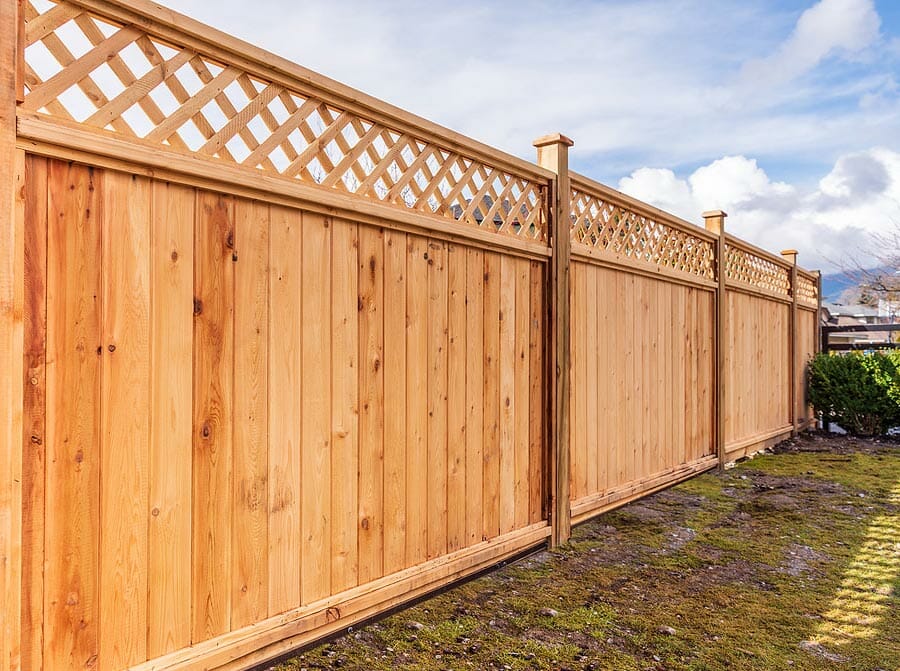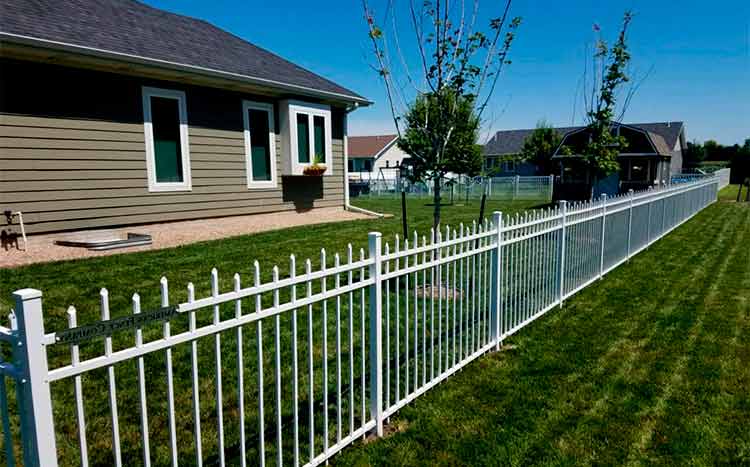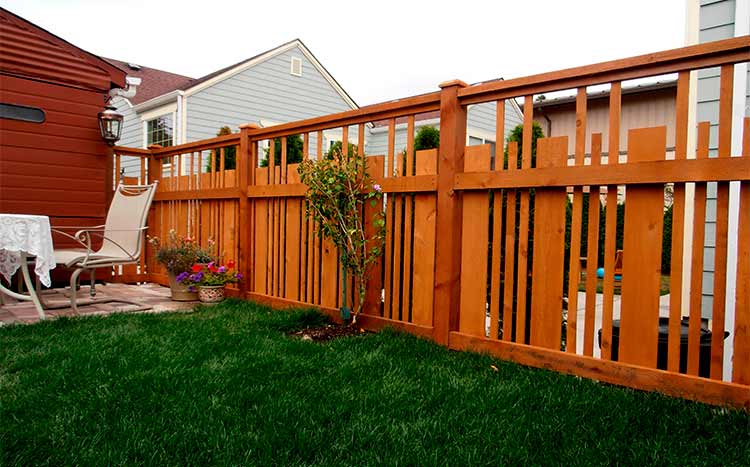Setting good boundaries is the secret to peaceful relationships, less stress, and more balance in life. The same applies to the boundary fence and property lines separating your property from your neighbor’s.
However, the concept of property boundaries is often misunderstood by property owners leading to many conflicts and arguments.
In such a case, the Oklahoma property line fence laws become critical in helping property owners resolve their differences.
Do I need a permit to build a fence in Oklahoma?
Yes! In most cities and counties, including Oklahoma City, you are required to hold a building permit to install a fence on a residential property. Other ordinances demand a permit for fences taller than 7 feet.
Therefore, if you opt to hire a fencing contractor, ensure that the company has obtained the required permits. You can also contact the local building department to find out whether you’ll need a permit.

Can I replace an existing fence without a permit?
No! A permit is needed when replacing, altering, or repairing an existing fence, especially where any modifications will be made regarding height, material, or location. But if you’re replacing the fence with a similar fence, most fence laws may exempt the need for a permit.
How tall can a privacy fence be in Oklahoma?
The maximum height allowed for residential fences in Oklahoma is 6 feet. Front yard fences are limited to about 4 feet in height, and the rear and side fences at 6 feet. In some cities, however, these height restrictions stand at 8 feet.
For corner lots, the height regulations are different in each city. Most ordinances set the limits between 3 – 6 feet. The key thing is to ensure the fence doesn’t obstruct the established sightlines.
Who owns the fence on property lines in OK?
Generally, the Oklahoma fence law recognizes the adjoining property owners as the fence owners on the property lines. The neighbors are legally required to share the responsibilities of its maintenance and repairs.
However, if one property owner decides to leave his/her land to lie open and unenclosed, they can’t be forced into responsibility for the fence.
If they later decide to enclose their land, he/she will have to refund the other neighbor a just proportion of the fence value at the time.
How do you know where the property boundary is?
Conducting a survey is one of the best ways to find your property boundaries. A surveyor will incorporate plat map details and other legal descriptions to find the exact location of your boundaries.
They will also bury survey pins and corner markers to make them easier to spot.
You can also check the property’s description on your deed or review your neighborhood’s plat map from the County Assessor’s office to find the boundaries.
Can my neighbor build a fence on the property line?
Yes! Your neighbor is free to erect a fence on the property line such that it’s partly on one side and partly on the other. In fact, according to Okla. Stat. Ann. tit. 4, § 152. the neighbor can do this without asking for your permission.
They can also remove that fence as if it was completely inside their property if it’s not more than 5 feet from that property line.
The good thing about this is that if you don’t want to enclose your land, your neighbor can’t force you into building or maintaining the fence.
However, if you keep livestock on your property, you may have to contribute towards the partition fence.

Can I put up a fence on my side of the property line?
Yes. The Oklahoma fence laws allow you to put up a fence inside your property right up to the property line. You won’t have to seek your neighbor’s permission, and the other neighbor has no right to remove that fence.
Nevertheless, you need to know the precise location of the property line before beginning the construction. You’ll also have to understand the fence height and zoning restrictions set by your county or Homeowner’s Association.
Who pays for the fence between neighbors in Oklahoma?
Under the Okla. Stat. Ann. tit. 4, § 142, adjoining neighbors are expected to pay equally for the maintenance and repairs of the boundary fence throughout the year, unless they agree otherwise in writing.
Neighbors who decide to leave their land open, however, won’t have to pay for the fence. They’ll only be responsible for half the costs of the division fence if they later decide to enclose their property.
If controversies regarding the fence payments occur, each neighbor is allowed to apply for fence viewers. These viewers are disinterested freeholders who will inquire into your dispute then, after due notice, inform each neighbor of their share and the time within to build or repair their portion of the fence.
What is a spite fence?
Spite fences refer to fences built for no beneficial purposes to the owner but to irritate or harm the neighbor. In most states, such fences are considered illegal mainly because they violate the local height or setback restrictions.
In Oklahoma, spite fences are addressed under the laws regarding private nuisance. If your fence injures or seems to deprive your adjacent neighbor’s enjoyment of their property, they can take you to court for it.
Based on past rulings of the Supreme court, the complaining neighbor can have the fence abated if they’re successful.
Oklahoma boundary fence laws at a glance
This table provides an overview of some of the state laws governing Oklahoma’s fence laws and links to their original documents.
| Statues | Boundary Fences: Maintenance | Boundary Fence: Removal or Replacement |
|---|---|---|
| Division Fence Statute: Okla. Stat. Ann. tit. 60, 70 Fence Removal: Okla. Stat. Ann. tit. 4, 152 | Owners of a boundary fence are equally required to maintain the fences between them unless one of the owners chooses to leave his/her land open as a public commons; If an owner later encloses their property, they must refund the other owner a just proportion of the value (at the time) of any partition fence that the owner erects. | An owner may erect a fence on the property line between their property and the neighbor’s so that the fence may be partly on one side and partly on the other; The owner of the fence has the right to remove it as if it were entirely on the his/her property, as long as the fence isn’t more than 5 feet from the line; An owner can’t remove the fence for malicious purposes or in a way that causes unnecessary harm to the other neighbor. |
Keep in mind; These laws are bound to change with time depending on the new legislation, federal court decisions, and other initiatives. Use the information provided above as a guide and research the latest regulations in your municipality.
FAQ’s
Who owns the fence between neighbors?
According to the Oklahoma fence laws, both adjoining neighbors are legally required to share responsibility for the fence unless they agree otherwise. But if one of the neighbors chooses to leave their property unenclosed, they won’t be forced into ownership.
What if a new fence is blocking my view?
Such a new fence can be considered a spite fence or private nuisance in the Oklahoma laws. As such, you can file a suit against the fence in court. If you can prove that its construction was purely based on spite, the court may have it abated.
Can my neighbor hang things on my fence?
Probably not. Unless you’ve agreed in writing to share that fence with your neighbor, they will have to ask for your permission before hanging things on your fence. Hanging things without your consent may be considered a criminal act.
Can I paint my side of the fence?
You’ll need the permission of your neighbor. If you feel that your side of your neighbor’s fence makes your property look bad, you’ll have to get their permission before repainting it. You might also have to consider the neighborhood’s ordinances regarding fence appearances.
Can I build a fence next to my neighbor’s fence?
Yes. If property owners don’t want to share a partition fence, they’re free to build their fences next to each other. The important thing is to ensure that the fence doesn’t encroach onto their neighbor’s side and doesn’t violate the local ordinances.
Is Oklahoma a fence in or fence out state?
Oklahoma is a fenced-in state. Under Title 4, Section 155 of Oklahoma Statutes, the law requires property owners with livestock to fence their property. If the animals trespass into the adjacent property, the owner is held liable for any damages caused.













